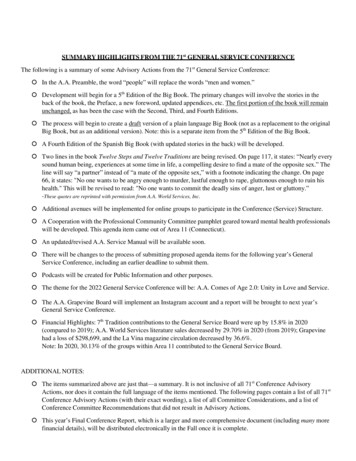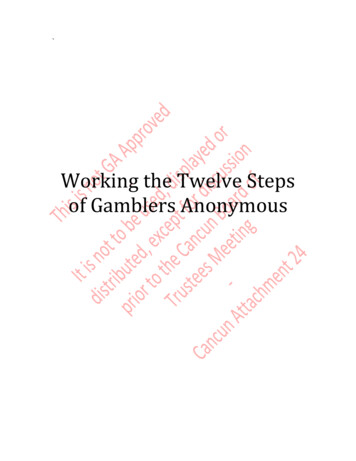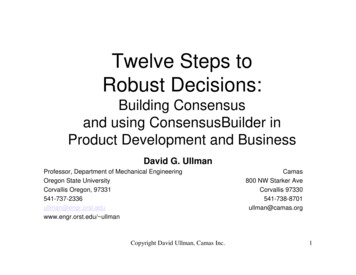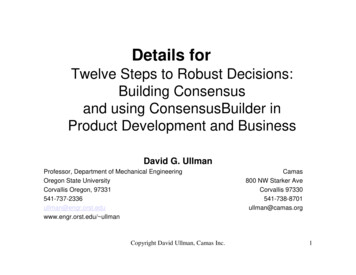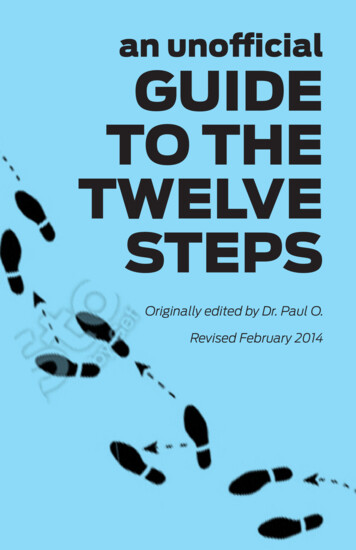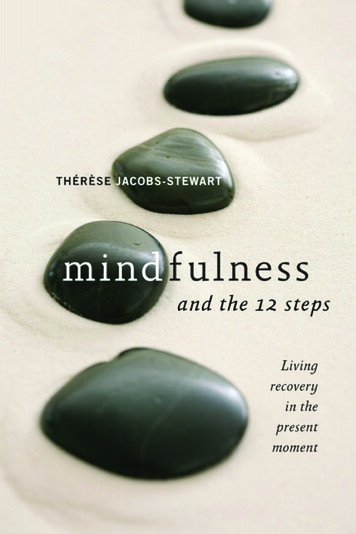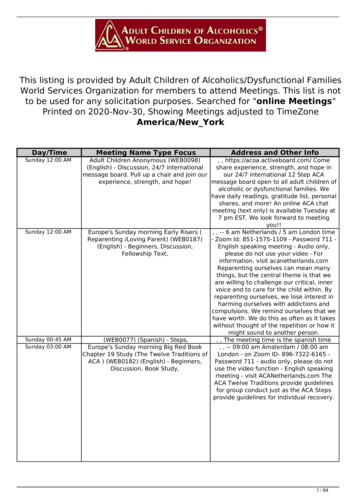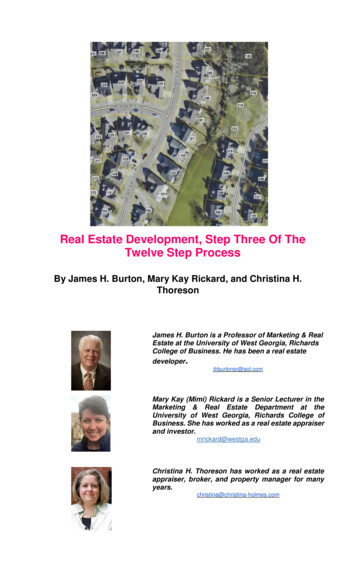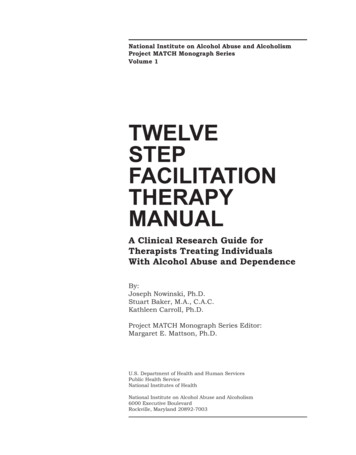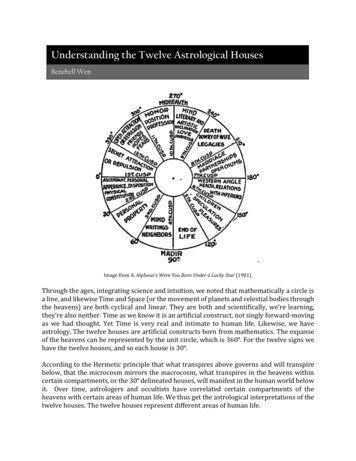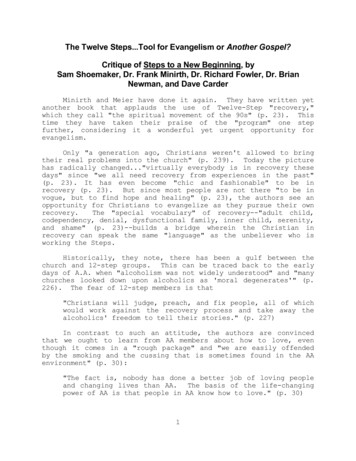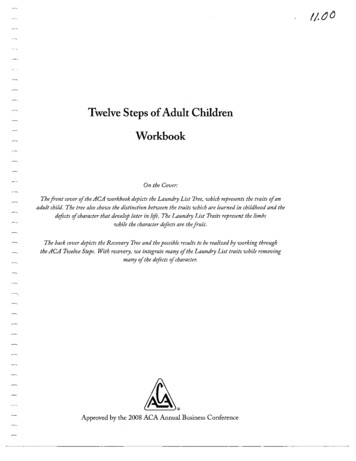
Transcription
Twelve Steps of Adult ChildrenWorkbookOn the Cover:The front cover ofthe ACA workbook depicts the Laundry List Tree, which represents the traits ofanadult child. The tree also shows the distinction between the traits which are learned in childhood and thedejects ofcharacter that develop later in lifo. The Laundry List Traits represent the limbswhile the character dejects are the fruit.The back cover depicts the Recovery Tree and the possible results to be realized by working throughthe ACA Twelve Steps. With recovery, we integrate many ofthe Laundry List traits while removingmany ofthe dejects ofcharacter.Approved by the 2008 ACA Annual Business Conference
Copyright 2007 byAdult Children ofAlcoholicsWorld Service OrganizationPost Office Box 3216Torrance, CA 90510www.adultchildren.orgAll rights reserved.Twelve Steps of Adult ChildrenWorkbookISBN 978-0-9789797-1-3Printed in the United States of America13 1415 14
' dultChild"What is an Adult Child?"The concept of Adult Child came from the Alateens who began the Hope for AdultChildren of Alcoholics meeting. The original members of our fellowship, who were over eighteenyears old, were adults; but as children they grew up in alcoholic homes. Adult Child also meansthat when confronted, we regress to a stage in our childhood." ACA History- an interviewwith Tony A., 1992.Editor's Note: More than a decade has passed since one of our primary founders, Tony A., wasinterviewed on the topic ofthe fellowship that he helpedfound with Alateen members in late 1977 and1978. For this book we will use Tony's words as the foundation to define the adult child personality.An adult child is someone who responds to adult situations with self-doubt, self-blame or a sense ofbeing wrong or inferior-all learnedfrom stages ofchildhood. Without help, we unknowingly operatewith ineffictive thoughts andjudgments learned in childhood. The regression can be subtle, but it isthere sabotaging our decisions and relationships.Note: Both of these items are from the introduc tory material of the ACA Fellowship Text (Steps and Traditions Book).This workbook is a companion book for Chapter Seven of the ACA Fellowship Text. Chapter Seven is the Twelve Steps chapter in theACA book.iii
The "Laundry List"(14 Characteristics of an Adult Child)These are characteristics we seem to have in common due to being brought up in analcoholic household.1. We became isolated and afraid of people and authority figures.2. We became approval seekers and lost our identity in the process.3. We are frightened by angry people and any personal criticism.4. We either become alcoholics, marry them, or both, or find another compulsivepersonality such as a workaholic to fulfill our sick abandonment needs.5. We live life from the viewpoint of victims and are attracted by that weaknessin our love and friendship relationships.6. We have an overdeveloped sense of responsibility and it is easier for us tobe concerned with others rather than ourselves; this enables us not to looktoo closely at our own faults, etc.7. We get guilt feelings when we stand up for ourselves instead of giving into others.8. We became addicted to excitement.9. We confuse love and pity and tend to "love" people we can "pity" and"rescue. "10. We have "stuffed" our feelings from our traumatic childhoods and havelost the ability to feel or express our feelings because it hurts so much(denial).11. We judge ourselves harshly and have a very low sense of self-esteem.12. We are dependent personalities who are terrified of abandonment and willdo anything to hold on to a relationship in order not to experience painfulabandonment feelings which we received from living with sick people whowere never there emotionally for us.13. Alcoholism is a family disease and we became para-alcoholics and took onthe characteristics of that disease even though we did not pick up the drink.14. Para-alcoholics are reactors rather than actors.- TanyA., 1978
ACA Twelve Steps1. We admitted we were powerless over the effects of alcoholism or other familydysfunction, that our lives had become unmanageable.2. Came to believe that a Power greater than ourselves could restore us tosanity.3. Made a decision to turn our will and our lives over to the care of God as weunderstand God.4. Made a searching and fearless moral inventory of ourselves.5. Admitted to God, to ourselves, and to another human being the exact natureof our wrongs.6. Were entirely ready to have God remove all these defects of character.7. Humbly asked God to remove our shortcomings.8. Made a list of all persons we had harmed and became willing to make amendsto them all.9. Made direct amends to such people wherever possible, except when to doso would injure them or others.10. Continued to take personal inventory and, when we were wrong, promptlyadmitted it.11. Sought through prayer and meditation to improve our conscious contactwith God, as we understand God, praying only for knowledge of God's willfor us and the power to carry that out.12. Having had a spiritual awakening as the result of these Steps, we tried tocarry this message to others who still suffer, and to practice these principlesin all our affairs.'-.,-,"' -''-. : .
The SolutionThe solution is to become your own loving parent. As ACA becomes a safe place for you,you will find freedom to express all the hurts and fears that you have kept inside and to freeyourself from the shame and blame that are carry-overs from the past. You will become anadult who is imprisoned no longer by childhood reactions. You will recover the child withinyou, learning to love and accept yourself.The healing begins when we risk moving out of isolation. Feelings and buried memorieswill return. By gradually releasing the burden of unexpressed grief, we slowly move out of thepast. We learn to reparent ourselves with gentleness, humor, love and respect. This processallows us to see our biological parents as the instruments of our existence. Our actual parentis a Higher Power whom some of us choose to call God. Although we had alcoholic or dysfunctionalparents, our Higher Power gave us the Twelve Steps of Recovery.This is the action and work that heals us: we use the Steps; we use the meetings; we use thetelephone. We share our experience, strength, and hope with each other. We learn to restructureour sick thinking one day at a time. When we release our parents from responsibility for ouractions today, we become free to make healthful decisions as actors, not reactors. We progressfrom hurting, to healing, to helping. We awaken to a sense of wholeness we never knewwas possible.By attending these meetings on a regular basis, you will come to see parental alcoholism orfamily dysfunction for what it is: a disease that infected you as a child and continues to affectyou as an adult. You will learn to keep the focus on yourself in the here and now. You will takeresponsibility for your own life and supply your own parenting.You will not do this alone. Look around you and you will see others who know how youfeel. We will love and encourage you no matter what. We ask you to accept us just as weaccept you.This is a spiritual program based on action coming from love. We are sure that as the lovegrows inside you, you will see beautiful changes in all your relationships, especially with God,yourself, and your parents.
The ACA Promises1. We will discover our real identities by loving and accepting ourselves.2. Our self-esteem will increase as we give ourselves approval on a dailybasis.3. Fear of authority figures and the need to "people-please" will leave us.4. Our ability to share intimacy will grow inside us.5. As we face our abandonment issues, we will be attracted by strengths andbecome more tolerant of weaknesses.6. We will enjoy feeling stable, peaceful, and financially secure.7. We will learn how to play and have fun in our lives.8. We will choose to love people who can love and be responsible forthemselves.9. Healthy boundaries and limits will become easier for us to set.10. Fears of failure and success will leave us, as we intuitively make healthierchoices.11. With help from our ACA support group, we will slowly release ourdysfunctional behaviors.12. Gradually, with our Higher Power's help, we will learn to expect the bestand get it.
How the ACA Twelve Step Workbook Was DevelopedThe ACA Twelve Step workbook was developed during a two-year period, beginning in2005. As part of the development and input process, ACA groups across the United States readand used the workbook in small groups and in one-on-one recovery between a sponsor andsponsee. These working groups submitted input and comments that shaped the tone, focus,and detail of this workbook.This workbook is a reformatted version of Chapter Seven from the ACA Fellowship Text(ACA "big book"). Chapter Seven and this workbook are very similar; however, the workbookhas questions at the end of Steps One, Two, and Three and additional writing assignments.Twelve Steps of Adult Children is designed as a Step-study book and stand alone piece ofliterature. It can serve as the main piece of literature for Twelve Step discussions at an ACAmeeting. The workbook also is designed to be used by ACA members wanting to work theACA Twelve Steps with a sponsor. Along with the writing assignments, there are worksheetsfor the Twelve Steps in addition to questions that help unlock clarity about our childhoodexperienc . !: and our new path of recovery. For example, Step Four contains 35 pages withdetailed writing and 12 workbook items on shame, abandonment, PTSD, feelings, and sexualabuse history. The ACA workbook also addresses the topics of grief and integration in additionto the Twelve Steps.With some modification the workbook can be used by a group of ACAs wishing to workthe Steps together during a 12-week to 16-week period.2005 Annual Business Conference of ACAThe 2005 Annual Business Conference of Adult Children of Alcoholics approved theconcept of a Twelve Step workbook that would accompany the ACA Fellowship Text. Thisworkbook is specific to the ACA experience of working and living the Twelve Steps.
What Does ACA Recovery Look Like?By working the Twelve Steps of ACA and by attending meetings regularly, we begin torealize that ACA recovery involves emotional sobriety*. That is what ACA recovery looks like.But what is emotional sobriety?To understand emotional sobriety, we must first understand emotional intoxication, whichis also known as para-alcoholism. Para-alcoholism represents the mannerisms and behaviorswe developed by living with an alcoholic or dysfunctional parent. As children, we took on thefear and denial of the alcoholic or nondrinking parent without taking a drink.Emotional intoxication can be characterized by obsession and unhealthy dependence. Therealso can be compulsion. Even without drugs and alcohol, we can be "drunk" on fear, excitementor pain. We can also be drunk on arguing, gossip, or self-imposed isolation.In essence the Laundry List, the 14 traits of an adult child, offers a textbook example of thebehaviors and attitudes that characterize an emotionally intoxicated person. We fear authorityfigures and judge ourselves harshly while being terrified of abandonment. Without help, weseek out others to reenact our family dynamics. We can recreate our family dysfunction at homeand on the job indefinitely until we find ACA. This means that our adult relationships resemblethe template relationship we developed as children to survive an alcoholic or otherwise dysfunctionalhome. We find others to create chaos, conflict, or unsafe relationships .Emotional sobriety involves a changed relationship with self and others. We measure emotionalsobriety by the level of honesty, mutual respect, and the acceptability of feelings in our relationships.If our relationships are still manipulative and controlling, we are not emotionally sober nomatter what we tell ourselves about our recovery program. Emotional sobriety means that weare involved in changed relationships that are safe and honest. We feel a nearness to our HigherPower. We cultivate emotional sobriety through the Twelve Steps and through association withother recovering adult children.' Emotional sobriety was fo rm ally introduced to the ACA fellowship th rough the Identity Papers. The 1986 paper, "Finding WholenessTh rough Separation: The Paradox ofI ndependence ," shows the genesis of emotional sobriety. The possibility of emotional sobriety iscreated through the broadening and deepening of the Steps a nd Traditions.
Part IACA Twelve Steps1he pathway to emotional sobriety that endures time is through the Twelve Steps of ACA.This is the heart of the Adult Children of Alcoholics program. Adapted from the time-provenSteps of Alcoholics Anonymous, the Twelve Steps are precision tools that work. The ACASteps clarify and help resolve a childhood of neglect, abuse, or rejection. With 30 years ofexperience, ACA is a proven program that offers a way out of confusion. The program bringsclarity and sanity in measures we always hoped for, but usually could not believe existed as wegrew up in dysfunctional homes.Since their original publication by AA in 1939, the Twelve Steps have relieved the sufferingof millions of alcoholics, addicts, codependents, food addicts, sex addicts, and many moreobsessive-compulsive types. The Steps, and their various adaptations, have brought sure hopeand a better way of life to those who desire change. In ACA, the Twelve Steps also bringrecovery to our members who were not raised with addiction in the home. Our experienceshows that these ACA members internalized the same abandonment and shame as childrenbrought up in alcoholism or other addictions.Beginning with Step One, we address denial, which can involve simply refusing to admitthat abuse or neglect occurred in our childhood. Denial also includes trivializing behavior orremarks that were obviously harmful to us. If we admit that harmful behavior occurred, wecan still be in denial if we fail to acknowledge the effects of the harm in our lives. Additionally,we are practicing denial if we attempt to explain away the behavior or to offer excuses for ourfamily. By breaking through our denial, we seek a full remembrance. We find our loss andlearn our story. With help and acceptance, we recognize the false identity we had to developto survive family dysfunction.In ACA, we learn to focus on ourselves and find our real identity. We must be willing towork the Twelve Steps so we can grow emotionally and spiritually. These are the Steps we workto address growing up in a dysfunctional family.1. We admitted we were powerless over the effects of alcoholism or otherfamily dysfunction, that our lives had become unmanageable.2. Came to believe that a Power greater than ourselves could restore usto sanity.3. Made a decision to turn our will and our lives over to the care of God as weunderstand God.1
Twelve Steps of Adult Children4. Made a searching and fearless moral inventory of ourselves.5. Admitted to God, to ourselves, and to another human being the exactnature of our wrongs.6. Were entirely ready to have God remove all these defects of character.7. Humbly asked God to remove our shortcomings.8. Made a list of all persons we had harmed and became willing to makeamends to them all.9. Made direct amends to such people wherever possible, except when to do sowould injure them or others.10. Continued to take personal inventory and when we were wrong promptlyadmitted it.11. Sought through prayer and meditation to improve our conscious contactwith God, as we understand God, praying only for knowledge of God'swill for us and the power to carry that out.12. Having had a spiritual awakening as the result of these Steps, we tried tocarry this message to others who still suffer, and to practice these principlesin all our affairs.The Twelve Steps are simple but not always easy; however, they work if a person truly wants tochange and can hang on while change occurs. The Steps sometimes work even ifa person picks at themlike afinicky childforking at a lump ofunwanted spinach. Such halfmeasures often create the personaldiscomfort that motivates the adult child into greater action and personal growth.By adapting AA's Steps, ACA is adding its flavor to the Steps while keeping intact the originalintent ofan admission ofpowerlessness followed by surrender. Such surrender is followed by a reviewofspiritual beliefs, selfinventory, making amends, and seeking conscious contact with a Higher Power.We develop a genuine attitude to live in love and service to ourselves and others.While ACA adapted theAA Steps with few word changes, our experience shows that the adaptationhas unique considerations. Because of our inherent sense ofbeingflawed or unlovable, the adult childmust be reminded that he or she has worth. We have worth and are acceptable, regardless of mistakesmade or accomplishments achieved or not achieved. As adult children we are a traumatized group ofadults, who can revert to selfdoubt when making errors or sensing disapproval by others. No adaptationof the Twelve Steps for adult child purposes will be fully successful unless it emphasizes selflove. Weare God's children despite mistakes made. Through such affirmations and Twelve Step work, we cometo believe in our self worth. We learn to tell ourselves that we are human and have something to offirthe world. We foce our mistakes and the opinions ofothers with confidence. In ACA, we get to say whowe are, instead ofa drunk or dysfunctional parent saying who we are not. This is the greatfoct for us.2
ACA Steps WorkbookWe have paid our dues with the countless cursings, threats, and subtle neglectful acts we have enduredas children. We stand now as adults, not complaining, but as people seeking to feel and be. We haveearned it. This is our claiming ofthe Twelve Steps and their rewards.Our solution appeals to cultures across the globe. Our members practice ACA recovery inEurope, Asia, Pacific Islands, and the Middle East in addition to North and South America.We have learned that children anywhere exposed to shame and abandonment develop the samesoul wound. When given an option as adults, many choose ACNs way oflife. The ACA programis a proven way of life that fulfills its members emotionally and spiritually.The term "adult child" does not mean that we live in the past or that we are infantile in ourthinking and actions. The term means that we meet the demands of adult life with survivaltechniques learned as children. Before finding recovery, we suppressed our feelings and wereoverly responsible. We tried to anticipate the needs of others and meet those needs so we wouldnot be abandoned. We tried to be flexible or supportive of others as we denied our own needs.We monitored our relationships for any sign of disapproval. We tried to be perfect so we wouldbe loved and never left alone. Or we isolated ourselves and thought we needed no one.As adults, we have been responsible team players or invisible loners. We are great employees,listeners, planners and party givers, but we respond to adult life with childhood survival traitsthat leave us feeling unsure of who we are. This is how we survived childhood, and this is howwe lived as "adult children."When faced with working ACN.s Twelve Steps, some adult children feel overwhelmed andbalk. Others are alarmed and believe they could be encouraged to abandon or confront theirfamilies. This is not the purpose of the ACA program. In ACA, we realize that our parentsdid not have the options that we have in ACA. If we were raised by relatives or grandparents,these people as well did not always have options. Our parents or relatives passed on familydysfunction. We are not minimizing the fact that many of our parents acted hostile, manipulative,or indifferent. Some dysfunctional parents were inebriated and pitiful. We balance our experiencesas children with the knowledge that we have a unique chance through ACA to break the cycleof family dysfunction. Even though our families may not seek recovery, we can respect them.We set appropriate boundaries to protect ourselves. We can disentangle our lives from theirlives without shutting them out completely.We ask the adult child considering ACA to look at the program as a way of life that willunfold over time, bringing rich rewards of emotional relief and self-acceptance. There will betransformations and healing grace as well. We suggest that ACA members work the Steps oneat a time, avoiding looking ahead and perhaps becoming overwhelmed. In ACA, we learn toslow down, breathe, and ask for help. The Steps work best when we surrender our self-sufficientattitudes and ask for help.Our experience shows that the Steps are a proven way of life, yielding new meaning and asense of purpose in one's life. We apply the Steps with willingness and honesty. In addition toaddressing dependence and addiction, the Twelve Steps awaken the person to an inner strength3
Twelve Steps of Adult Childrenthat comes with a true connection to his or her Higher Power. We have always had this innerstrength. Even when we appeared pitiful and helpless, the strength was there helping us surviveuntil we could find real help. The Twelve Steps bring forth this God-given strength and truechoice or discernment. With the Steps and true choice, we can finally breathe deeply andfeel joy.Making a BeginningBeginning with Step One the adult child begins to realize, perhaps for the first time, thedestructive malady of growing up in an alcoholic or other dysfunctional home. In addition toshame, our families included perfectionism, rage, mental illness, sexual abuse, religious abuse,or illicit drug use. Some parents were hypochondriacs who abused prescriptions and used anendless number of ailments to control others. By working the Steps and attending meetings,we see that we are not unique and that our family is not unique as well. There are millions ofpeople like us. In ACA, we begin to acquire the language we need to describe what happenedto us in a manner that has meaning and resonance. Even adult children with years of TwelveStep experience in other programs gain a new awareness of family-of-origin issues by workingthe ACA Steps.By working the Twelve Steps with a sponsor or knowledgeable counselor, the adult childrealizes the denial and secrecy that were necessary to survive such an upbringing. Denial, whichfosters a lack of clarity, is the glue that allows the disease of family dysfunction to thrive.Cloaked in dcni .l, the dis ase is passed on to the next generation with amazing consistency.'T'he Sasic language of denial is: "don't talk, don't trust, don't feel."l"\'Vitl1 Vlep One we come out of denial and talk about what happened. We bring details tolight. Many of us have smelled our parents' drunken breath. We have found hidden whiskybottles and pill bottles. We have cleaned up vomit. We have comforted a frightened brotheror sister. The police have been called to our home. Our neighbors talked about our family.We avoided having friends over because we feared how our parents might act in front of them.We have made excuses for our parents, pleaded with our parents and condemned them withno real change. We have hidden illicit drugs and lied to neighbors. We have slept with ourclothes on and ready to run. Some of us have thrown water on a mattress accidentally lit by apassed out mother or father. We have burned with shame after being cursed or belittled. Wehave listened to a parent's promises to change but have seen no lasting results. We have heardour parents curse one another regularly, swapping insults and hurtful claims. We have listenedto them rehash the same blame and threats year after year. Nothing changed. We have seenour parents run up great sums of debt to buy affection or happiness. Our utilities have beencut off for nonpayment. We have lied to the collection agency for our parents. We haveexperienced divorce or heard talk of divorce that never came. Our siblings may have rememberedthings differently, but we know our own truth. We know what happened and we are breakingour silence.lIt Will Never H appen to Me, by Dr. Claudia Black-19814
ACA Steps WorkbookFamilies without alcoholism have similar situations. These families abuse the childrenthrough the use of intellect, manipulation, or silence. We know our truth.By working the Steps, the adult child realizes family roles that were required to approximateprotection in an unsafe home. We often feared for our safety and took on roles to disarm ourparents. Some of us sought to be invisible. The roles which are usually present in alcoholic anddysfunctional homes include "family hero, lost child, scapegoat, and mascot."2 Some of theroles allowed us to be a parental favorite. As the favorite, we could temporarily dodge harmfulbehavior that could be shifted to a brother or sister. However, we were harmed by the processas well or when it was our turn to be abused, neglected or rejected. In addition to physicalabuse, we were subjected to emotional abuse. The emotional abuse involved belittling commentsor hatefulness aimed at our hearts. The abuse left no visible marks, but it is stored in our bodiesjust the same as slapping and hitting leave marks on the body.In addition to creating false safety, our childhood roles had other functions. The hero childof a dysfunctional family might seek to make good grades at school. This is the honors studentwho shows the world that her family values education and is therefore stable. The mascot,typically the youngest of the family, serves as comic relief for dysfunctional homes that leavelittle room for joy. The lost or invisible child remains silent. The child knows it is not safe tospeak. The lost child retreats to his or her room and remains absorbed in reading books orfantasies ofliving elsewhere. The scapegoat child lives out the parents' prophesy of being a bador rotten kid. These are the roles that are almost predictable for any family in which dysfunctionalparenting is present.Such survival roles tend to have a hardy life and remain fixed in our personalities long afterwe have left our unhealthy homes. Adult children finding recovery learn about such dysfunctionalroles. They can look at their families and see the roles in effect decades after the children havegrown up and left the family. There is the 50-year-old brother still playing the hero. There isthe 40-year-old sister, living out the lost child role by avoiding holiday meals and rarely callinghome. This is difficult to watch once we find ACA and begin our recovery journey. The adultchild in recovery gets the chance to retire his or her role with dignity. We are never too old towork an ACA program and receive its benefits.In addition to learning about survival roles through the Twelve Steps, many adult childrenrealize they have absorbed generational shame, abandonment, and rage only to grow up andrecreate similar families or relationships . They realize they wanted to fix others. Withoutfocused help, many ACAs spend their lives in adult relationships trying to repair their originalfamily. Who hasn't read a story about a child with an ailing parent growing up to be a doctorin an effort to find a cure for the ailing parent? Adult children are no different. We want toheal our drunken or dysfunctional parents by acting good, silent, or by taking care of them.But the "sickness" the adult child attempts to cure in the parent is the disease of dysfunction,which we have no power over.' Roles by Sharon W egscheider5
Twelve Steps of Adult ChildrenThe ACA Identity Papers identify this behavior as our main problem-a mistaken beliefthat we could have changed our parents. Additionally, The Problem, read at ACA meetings,underscores our attempts to heal or rescue others. It states: "We confused love with pity, tendingto love those we could rescue." Trying to rescue or heal our parents set the course of our lives.Many ACAs grow up believing they have failed in healing their families without realizing itwas never their job to do so. As adults, many of us subconsciously attempt to heal our familiesin our adult relationships by disguised designs. In ACA, we realize we have no power overalcoholism and family dysfunction. We cannot change anyone but ourselves.At the same time, some of us were so abused or belittled as children that we felt powerlessto have any effect on our parents' behavior. The thought of healing or changing them neveroccurred to us. However, we grew up with the same loss, shame and self-hate as other adultchildren. Like others, we turned to control in adulthood for a sense of safety.Without recovery, we, as adult children, intuitively find dysfunctional people and attemptto heal them or cure them based on our upbringing. We confuse love with pity and get unhealthydependence. ACA experience shows that such behavior dooms relationships. We cannot changeanyone. The only person we can change is ourselves, and an adult child rarely changes unlesshe or she becomes willing to learn a new way to live. The good news is this: There is anotherway to live.The ACA fellowship offers hope to any adult child, who can realize he or she has hit abottom and become willing to attend meetings, work the Twelve Steps, and seek a HigherPower of his or her understanding. There are many types of bottoms in ACA. Some of ourmembers hit a bottom with alcoholism or addiction. Others hit a bottom in codependentrelationships that can be just as addictive as drugs. For instance, some adult children becomeobsessed and develop a compulsion for another person that is similar to the addict's obsessionand compulsion for drugs. The "withdrawal" from an addictive, codependent relationship canbe just as painful, if not more painful, as an addict's withdrawal from drugs. ACA membersknow that codependent pain can grip a p
the Steps together during a 12-week to 16-week period. 2005 Annual Business Conference of ACA The 2005 Annual Business Conference of Adult Children of Alcoholics approved the concept of a Twelve Step workbook that would accompany the ACA Fellowship Text. This workbook is specific to the ACA experience

